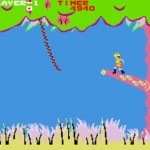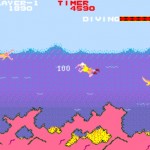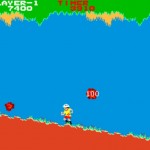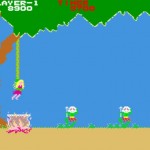JUNGLE HUNT
By Sean HarrisInitially titled JUNGLE KING (and released limitedly as such) before being sued by the Edgar Rice Burroughs estate over copyright infringement due to a few similarities between their tree swinging player character and a trademarked Tarzan, JUNGLE HUNT was slightly augmented and put back in mass production to become the platformer we all grew to fall in love with at local arcades and pizzerias. The object of the game was simple: challenge the four safari-themed action sequences to save your kidnapped sweetheart from a clan of flesh hungry cannibals. For a quarter, you got three attempts to etch your high score into the ram.
The first stage has you leaping through treetops, which only requires being patient and timing your jumps when the swinging lines align in your favor. Take your time and you’ll soon dive from the high branches into the crocodile river, where you must cross to the other side while trying to dodge reptile teeth and avoid rising air bubbles that will push you uncontrollably into harms way. You also have to keep on eye on your breath meter at the top of the screen, and surface to replenish air before it runs down and your lungs burst (kind of a neat little addition to keep things tense). You can choose to weave around the approaching ‘gators, or attack them head on with your trusty dagger for extra point value.
Scenario three is running up a craggy mountainside while small and large boulders come crashing down. Give yourself enough space to leap over the little rocks, and position yourself for a quick duck at the right spot as the giant ones come tumbling. When you finally conquer the hill, you’ll be in the final stage for a quick mission: make it past the two spear-carrying head hunters, and snatch your lady fair from the imprisoning rope that holds her over a boiling pot. If you’re successful, and after a little rendezvous animation screen, the stages repeat with background color changes and higher difficulty curves. Added elements (like pesky monkeys waiting on select vines who try to knock you off) are introduced, and enemy speeds and patterns change. It gets tough very quickly, so be prepared to be humbled.
Unusual for a side-scroller is the fact that JUNGLE HUNT pans right to left as it advances, instead of the traditional opposite direction generally used (even for the age it came out of, this was an odd design decision). The controls are as simple as the premise; you have a multi-directional joystick, and a singular action button, which for the most part is for performing jumps–though on stage two it doubles as your stabbing mechanism. Also, only in the water phase are all four trajectories are used; everywhere else is on a fixed course from the right (you can actually turn around and walk backwards on the final scene, however).
Old school but still remaining cool, JUNGLE HUNT was a popular favorite on the arcade scene that saw plenty of replay value. For its time, it had colorful graphics, displaying slightly more detail than the likes of DONKEY KONG and PAC-MAN and all of the vector-based games that were cluttering up the market. It even sported some very early parallax scrolling, as coral reefs, sand, bushes and trees moved at independent rates to create a 3D like depth of field.
There’s also some decent sound down inside the speakers, featuring a main adventurous march, upbeat heroic jingle, tribal drum beats, and even a few movie samples (the crocodiles make a cartoon electronic sounding burp when they consume you, which is amusing. Sadly, the call of the wild scream was deleted with the copyright restrictions, but you can track the original release down now with ease for M.A.M.E and see all the deleted content). JUNGLE HUNT may be an unsophisticated relic by todays standards, but with an easy control scheme and pick and go style, is still fun to fire up and challenge to this day.



